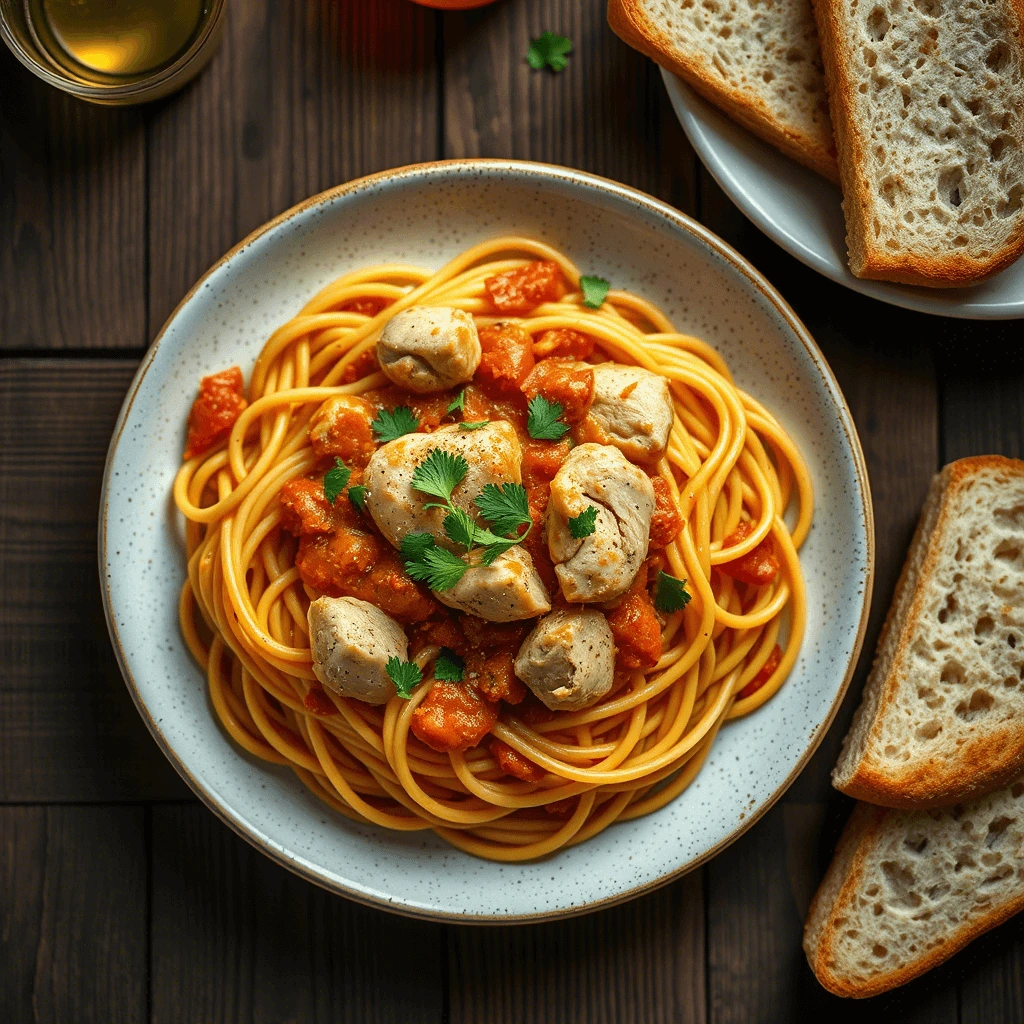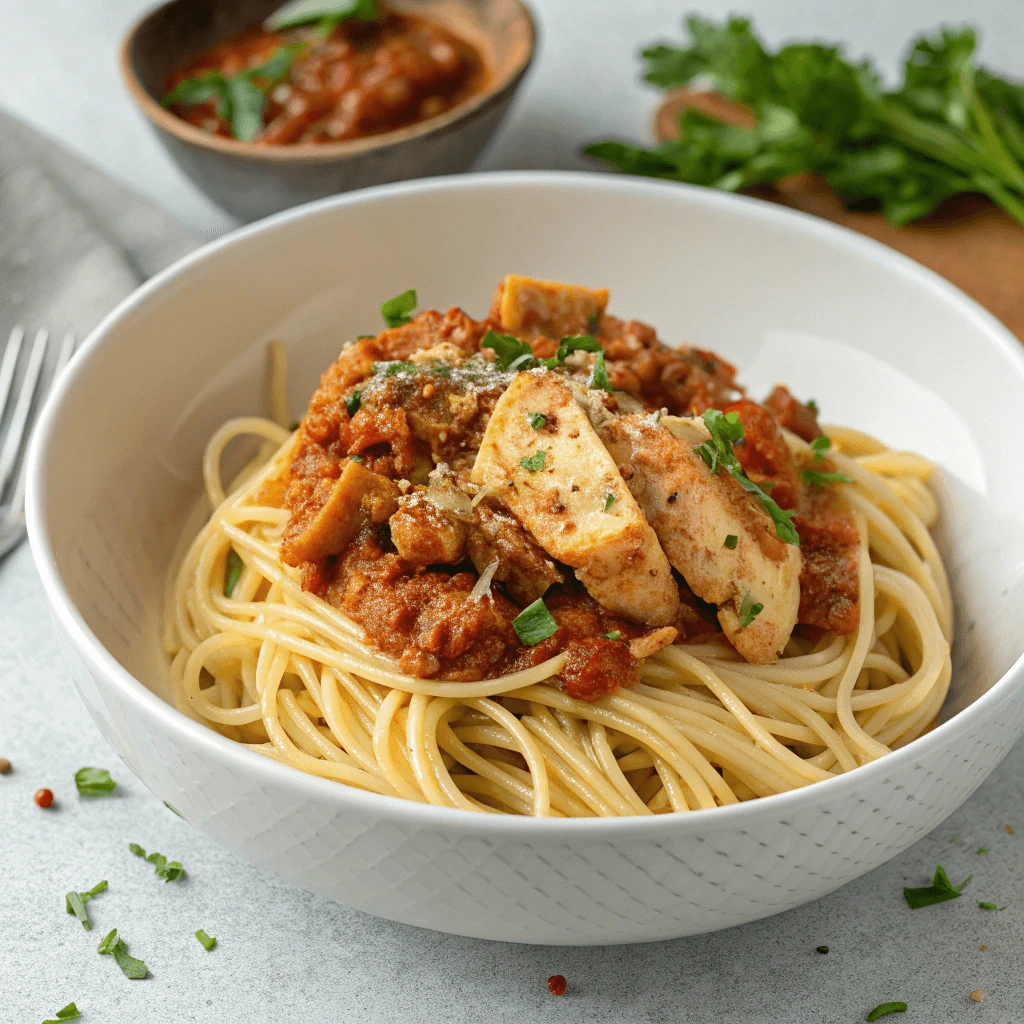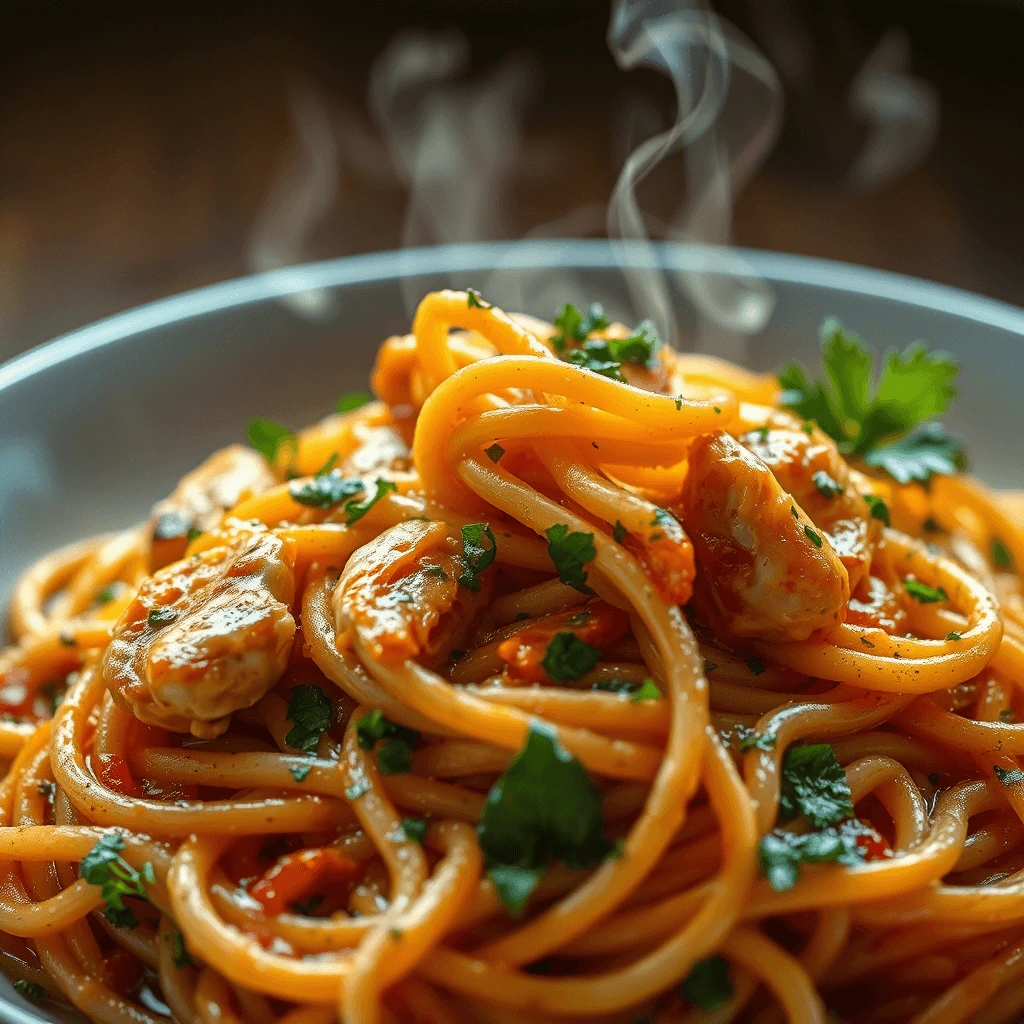If you’ve been searching for a chicken spaghetti recipe that’s creamy, flavorful, and guaranteed to impress, your hunt ends here. This isn’t your average weeknight pasta—it’s a comforting, cheesy classic made even better with a few game-changing secrets. Whether you’re cooking for a big family, hosting a potluck, or just want something satisfying after a long day, this chicken spaghetti delivers comfort in every bite.
In this post, I’ll walk you through 7 simple secrets that turn a basic chicken spaghetti into a dish everyone will rave about. From choosing the right cut of chicken to unlocking rich, savory layers with pantry staples like garlic, cheese, and Rotel tomatoes, these tips will help you create a meal that’s both easy to make and impossible to forget. So grab your favorite casserole dish and let’s get started on your new go-to dinner!
Flavor Starts with the Base
Use Bone-In or Thigh Meat for Extra Flavor
When it comes to crafting the perfect chicken spaghetti recipe, the type of chicken you use makes a big difference. While boneless, skinless chicken breasts are a common go-to for convenience, they can sometimes fall short in the flavor department. That’s why one of the best-kept secrets is opting for bone-in chicken or thigh meat instead.
Why bone-in or thighs? The bone and dark meat contain more natural fats and connective tissue, which break down during cooking to create a richer, deeper flavor. This not only enhances the taste of the chicken itself but also infuses the entire spaghetti dish—especially if you’re simmering the chicken in broth or letting it cook in the sauce.
Thigh meat is also juicier and more forgiving, meaning it stays tender and flavorful even if it’s cooked a little longer than intended (great news if you’re juggling a busy kitchen!).
If you’re short on time, you can use pre-cooked rotisserie chicken, but if you’re making it from scratch, bone-in thighs or drumsticks simmered in seasoned broth will reward you with a next-level base for your dish.
Sauté Aromatics Like Garlic and Onion
One of the simplest yet most powerful ways to boost the flavor of your chicken spaghetti recipe is to start with a solid foundation—aromatics. These are the ingredients that release bold, fragrant oils when cooked, and two of the most essential are garlic and onion.
Sautéing these aromatics in a bit of olive oil or butter before adding any other ingredients creates a depth of flavor that can’t be matched. When onions soften and become translucent, they release natural sweetness. Garlic, when lightly sautéed (not burned!), adds a warm, savory punch that enhances everything that follows. Together, they act like a secret seasoning base that makes the final dish taste like it simmered all day—even if it didn’t.
Want to take it a step further?
Add diced bell peppers or a pinch of red pepper flakes for a Southern-inspired kick. Some home cooks also love tossing in a bit of chopped celery for added texture and aroma—especially if you’re going for a more classic, casserole-style vibe.
Cooking Tip:
Use medium heat and stir frequently. Burnt garlic can turn bitter fast, so add it just after the onions begin to soften and cook it for only 30–60 seconds until fragrant.
By giving a few extra minutes to this step, you’re layering flavor from the ground up—and trust me, it makes a huge difference when that creamy sauce and tender chicken come into play.
Use Chicken Broth Instead of Water to Boil Spaghetti
Here’s a pro-level tip that can instantly elevate your chicken spaghetti recipe: boil your pasta in chicken broth instead of plain water. It’s a simple swap, but the flavor payoff is huge.
When you boil spaghetti in water, it soaks up very little flavor—just enough salt if you’ve remembered to season it. But when you use chicken broth, the pasta absorbs the rich, savory taste of the broth as it cooks, infusing every bite with extra depth. This trick ties the pasta and sauce together beautifully, creating a cohesive, restaurant-quality dish.
How to do it:
You don’t have to use 100% broth—a 50/50 mix of broth and water works well if you’re watching sodium or want to stretch your broth. Just be sure to salt lightly if your broth is already seasoned.
Bonus Tip:
If you’ve simmered your own bone-in chicken earlier in the process (see Secret #1!), save that homemade broth and use it to cook your spaghetti. Not only is it more flavorful than store-bought, but it also ties everything together in a rich, homemade way.
Vegetarian Tip:
If you’re adapting this recipe for a meatless version, a good-quality vegetable broth will still boost your pasta far beyond what plain water can do.
This little trick is one of those “why didn’t I do this sooner?” moments—and once you try it, you’ll never go back to basic boiling water again.

Creamy, Cheesy, and Comforting
Add Cream of Mushroom (or Homemade White Sauce)
One of the most iconic ingredients in a classic chicken spaghetti recipe is cream of mushroom soup—and for good reason. It brings the perfect balance of creaminess, umami depth, and that cozy, comforting texture we all crave in a baked pasta dish. But if you want to take things up a notch, you’ve got two delicious options: stick with the classic canned version for convenience or whip up a homemade white sauce for a from-scratch upgrade.
The Classic Shortcut
Using canned cream of mushroom soup is a time-saving staple that blends beautifully with shredded chicken, pasta, and cheese. It creates a thick, creamy base that holds everything together and gives the dish that signature casserole feel. For an extra layer of flavor, go for a “roasted garlic” or “herb-seasoned” version if available.
The From-Scratch Option
Want more control over the ingredients and flavor? Try making your own white sauce (béchamel) with just a few pantry basics—butter, flour, milk, and sautéed mushrooms. Add a touch of garlic, onion powder, salt, and pepper for seasoning. The result is a silky, rich sauce without preservatives, and you can customize it to be as mild or bold as you like.
Bonus Add-Ins:
Chopped spinach, caramelized onions, or roasted red peppers can be stirred into either version of the sauce to add color, texture, and extra nutrition.
Whether you’re keeping it simple or going all out, the key is to create a sauce that evenly coats the pasta and chicken without being too runny or dry. It should cling to every bite—creamy, savory, and completely comforting.
Don’t Skimp on Cheese – Use a Blend
Let’s be honest—what would a comforting chicken spaghetti recipe be without a generous helping of cheese? It’s the ooey-gooey magic that brings all the flavors together and gives this dish its signature indulgence. But here’s the secret: don’t just rely on one type of cheese. For the best texture and flavor, it’s all about the blend.
Cheddar Is the Classic Backbone
Sharp cheddar is the go-to in most traditional recipes because it melts beautifully and adds a bold, tangy bite. It’s what gives baked chicken spaghetti its golden, slightly crisp top and creamy, satisfying interior.
Mozzarella for Melt & Stretch
Add mozzarella for that gooey cheese pull everyone loves. It’s milder in flavor than cheddar, which helps balance out the sharpness and adds a smooth, stretchy texture that makes every bite irresistible.
Parmesan for Depth and Saltiness
Just a small handful of freshly grated Parmesan can elevate the dish with a nutty, salty depth. Sprinkle it on top before baking for a slightly crisp, golden-brown finish.
Optional Extras:
Feeling fancy? Try mixing in Monterey Jack for a mild, creamy bite or pepper jack if you want a hint of heat. A bit of cream cheese or ricotta can also make the sauce extra rich and velvety.
Pro Tip:
Always shred your cheese fresh if you can. Pre-shredded cheese often contains anti-caking agents that can prevent it from melting smoothly, and fresh cheese simply tastes better.
Cheese is one of the main flavor drivers in chicken spaghetti, so don’t hold back. A good blend makes the difference between a basic casserole and a dish that has people asking for seconds (and thirds!).
Stir in Rotel Tomatoes for Tang and Spice
If you’re looking to give your chicken spaghetti recipe a bold, flavorful edge, Rotel tomatoes are your secret weapon. These canned diced tomatoes, mixed with green chilies, add just the right amount of tang, heat, and brightness to cut through the creaminess of the cheese and sauce.
Why does this matter? Because a rich dish like chicken spaghetti needs a little contrast to keep it exciting—not just heavy and cheesy. Rotel delivers that contrast perfectly. The tomatoes bring a juicy acidity, while the chilies add a gentle kick of spice that even picky eaters often love.
Flavor Balance
Rotel keeps the flavor profile from being one-note. That little zing makes each bite pop, and it pairs beautifully with cheddar and chicken. It also gives your sauce a subtle reddish hue that makes the final dish look even more appetizing.
Choose Your Heat Level
Rotel comes in mild, original, and hot varieties, so you can choose what works best for your family’s spice preference. Mild is great for kids and spice-sensitive eaters, while hot adds a bold Southwestern flair.
No Rotel? No Problem.
If you can’t find Rotel, use a can of diced tomatoes and add a few tablespoons of chopped green chilies or a pinch of red pepper flakes to mimic the flavor.
Pro Tip:
Drain Rotel slightly before adding it to prevent your sauce from becoming too watery. You want that tangy kick without thinning out the creamy texture you worked so hard to build.
Adding Rotel is one of those easy tweaks that takes the dish from predictable to next level. It’s a tiny can with a big impact—don’t skip it!

Bake It for the Finish
Bake Until Bubbly and Golden
You’ve layered in all the creamy, cheesy goodness, stirred in your seasoned chicken, and cooked the pasta just right—now it’s time for the grand finale. Baking your chicken spaghetti is more than just reheating everything together—it’s the moment when all the flavors marry and the top transforms into a golden, bubbly masterpiece.
Why Bake?
Baking locks everything into place. It thickens the sauce, allows the cheese to fully melt into every nook and cranny, and creates that irresistible golden crust on top that everyone fights over. The oven brings it all together in a way the stovetop simply can’t.
Time & Temperature Tips:
Bake your chicken spaghetti uncovered at 350°F (175°C) for 25–30 minutes. You’re not cooking anything raw at this point—just melding flavors and getting that perfect finish. You’ll know it’s ready when the edges are bubbling and the top is lightly browned and gooey.
Pro Tip for Extra Golden Top:
Sprinkle a final layer of shredded cheddar or a mix of Parmesan and mozzarella over the top before baking. For even more golden crispness, broil for 2–3 minutes at the end, keeping a close eye so it doesn’t burn.
The Visual Cue:
Look for bubbling edges and a golden cheese topping with slightly crisp corners. That’s the sign it’s time to take it out, let it rest, and get ready to wow your family or guests.
Baking is the last step that turns your chicken spaghetti from a stovetop mixture into a real comfort food classic. It’s that final touch that says: “Yes, this was made with love.”
Let It Rest Before Serving
It might be tempting to dig right into your bubbling, cheesy chicken spaghetti the moment it comes out of the oven—but hold up just a few minutes! One of the most underrated secrets to the perfect chicken spaghetti recipe is letting it rest before serving.
Why Resting Matters
Right out of the oven, the sauce is still in motion—hot, loose, and bubbling. Letting the dish sit for 5 to 10 minutes gives it time to cool just slightly and allows the sauce to thicken up naturally. This resting period helps everything settle, so when you slice or scoop it onto a plate, you get beautifully layered portions instead of a runny mess.
Better Texture & Easier Serving
Resting makes it easier to serve clean, cohesive portions without the cheese sliding off or the pasta spilling everywhere. The flavors have a chance to finish melding, and the texture becomes creamier and more satisfying.
Pro Tip:
If you’re baking it for guests or a special occasion, loosely tent the dish with foil to keep it warm while it rests. This helps retain heat without trapping steam that could make the top layer soggy.
Perfect Time to Garnish
This is also the ideal time to add final touches—freshly chopped parsley, a sprinkle of Parmesan, or a few twists of black pepper for a little visual and flavor boost.
Letting your chicken spaghetti rest is a small step with big rewards. It gives the dish that polished, ready-to-serve feel—like something straight out of a cozy family cookbook.
Bonus: Make It Ahead or Freeze for Later
One of the best things about a hearty chicken spaghetti recipe is that it’s not just delicious—it’s also incredibly freezer-friendly. Whether you’re prepping for a busy week, feeding a crowd, or just love having comforting meals ready to go, this dish is the ultimate make-ahead superstar.
How to Make It Ahead
You can prepare the entire casserole up to a day in advance. Simply assemble everything in a baking dish, cover tightly with foil or plastic wrap, and store it in the fridge. When you’re ready to cook, just pop it in the oven and add an extra 10–15 minutes of bake time if it’s going in cold.
Freezer Instructions
Chicken spaghetti freezes beautifully—especially before baking. Assemble it in a disposable foil pan or a freezer-safe glass dish, cover well (first with plastic wrap, then foil), and label it with the date. It’ll keep in the freezer for up to 3 months.
To Bake From Frozen:
- Let it thaw overnight in the fridge for best results, then bake as usual.
- Or bake it straight from frozen at 350°F (175°C), covered with foil for the first 30–40 minutes, then uncovered for 15–20 more minutes until hot and bubbly.
Pro Tips for Freezing:
- If you’re using a homemade sauce, let it cool completely before mixing it with pasta to avoid mushiness.
- Wait to add the final cheese topping until just before baking for a fresher, meltier result.
Perfect for Gifting or Meal Trains
Chicken spaghetti also makes a fantastic gift for new parents, neighbors, or anyone in need of a little comfort food. Wrap it with a note and reheating instructions—it’s a thoughtful, delicious gesture that goes a long way.
Whether you’re planning ahead or saving leftovers for a rainy day, this dish proves that comfort food can also be convenient.

Your Perfect Chicken Spaghetti Starts Here
There you have it—7 simple yet powerful secrets to creating the ultimate chicken spaghetti recipe your family will ask for again and again. From building flavor with bone-in chicken and sautéed aromatics, to creating a creamy, cheesy finish and baking it to golden perfection, each step brings you closer to a dish that’s comforting, crowd-pleasing, and seriously crave-worthy.
Whether you’re making it fresh tonight or freezing it for a cozy dinner down the road, this recipe is flexible, flavorful, and always satisfying. Don’t be afraid to make it your own—add your favorite cheese combo, spice it up with Rotel, or sneak in some veggies for a healthier twist.
Now it’s your turn—give these tips a try and taste the difference!
If you loved this post or have your own secret for perfect chicken spaghetti, drop a comment below—I’d love to hear from you. And if you’re feeling generous, share this recipe with a friend who could use a little weeknight dinner inspiration.

